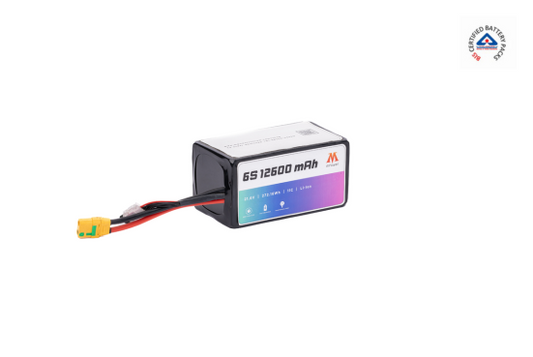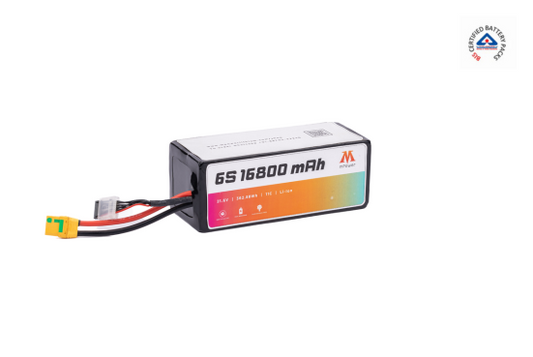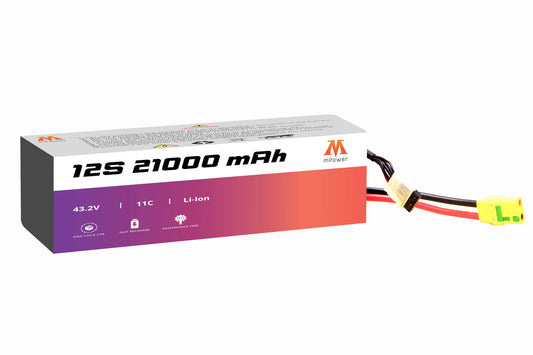The drone market is expected to grow from $4 Billion in 2021 to $9.6 billion by 2026, with a CAGR of 19% from 2021 to 2026. The wide use of drones in agriculture, logistics, healthcare and transportation industries has created lucrative opportunities for the various drone component manufacturers, especially drone batteries. However, the drone battery technology also has gone through numerous evolutions with the time i.e. from NiMH to LiPo to finally Li-ion. Over the years, drone rechargeable battery technology has evolved remarkably, with lithium-ion batteries emerging as the driving force behind their soaring capabilities.
The Early Days: From NiMH to LiPo
Before the widespread adoption of lithium-ion batteries, drones relied on Nickel Metal Hydride (NiMH) and Lithium-Polymer (LiPo) batteries. These batteries laid the foundation for drone flight but had limitations regarding energy density, weight, and overall performance.
NiMH batteries offered better energy density than their predecessors, but they were relatively heavy and had limited discharge rates. On the other hand, LiPo batteries provided higher energy density and discharge rates, allowing drones to achieve longer flight times and increased agility. However, both NiMH and LiPo batteries suffered from drawbacks such as self-discharge, limited cycle life, and the risk of thermal runaway.
The Rise of Lithium-Ion Batteries
Lithium-ion (Li-ion) batteries revolutionized the drone industry by providing a range of advantages over previous battery technologies. The lithium battery for drones offer higher energy density, meaning they can store more power in a smaller size. They also have lower self-discharge rates, allowing them to hold their charge for longer periods. Moreover, Li-ion batteries have a longer cycle life, meaning they can be recharged and reused multiple times without significant degradation.
Li-ion batteries have a significant advantage in terms of energy storage capacity compared to other types of batteries. This means drone manufacturers can create sleek and aerodynamic models without sacrificing flight duration. Another benefit is that Li-ion batteries maintain a consistent power output throughout their usage, ensuring stable performance until they are depleted.
Innovations in Li-ion Batteries
Innovations never cease. Future prospects in drone technology drive engineers to work towards continuously enhancing the current technology.
- Energy Density: Even though Li-ion batteries provided higher energy density than previous technologies, researchers recognized the potential for further enhancement. Their efforts focused on exploring new materials and battery chemistry to boost energy density. This advancement would enable drones to achieve even greater flight distances on a single charge.
- Safety: In initial days, safety was a major concern regarding Li-ion batteries, not only in the drone industry but also in other sectors. However, technological advancement has eliminated the potential for thermal runaway.
- Cycle Life: As drones became more widely used for commercial applications, users demanded batteries with longer cycle lives. Manufacturers responded by refining battery chemistries and electrode designs to extend the number of charge-discharge cycles a battery could undergo without significant degradation.
- Fast Charging: As drones gained popularity in commercial applications, users started seeking batteries that could recharge quickly to meet their demands. In response, engineers are innovating better Li-ion battery chemistries to exceed customer expectations.
The Future of Lithium-Ion Drone Batteries
The drone industry is poised for exciting advances with the future of lithium-ion batteries. Battery technology is undergoing significant developments that are set to revolutionize how drones function. One important research direction focuses on solid-state batteries, which promise higher energy density, faster charging capabilities, and improved safety. These batteries have the potential to elevate drone efficiency and performance by enabling longer flights and quicker turnaround times.
There are also hybrid systems that integrate lithium-ion batteries with complementary technologies like supercapacitors in development. This approach enhances energy storage for different drone operations, ensuring optimal performance in various scenarios. Additionally, wireless charging solutions have the potential to transform drone operations by enabling seamless in-flight recharging or automated landing on charging pads.
With sustainability becoming increasingly important, the focus on eco-friendly and recyclable battery designs is growing. This aligns drone technology with environmentally conscious practices. As the industry continues to progress, the future of lithium-ion drone batteries holds great potential for safer, more efficient, and environmentally friendly aerial operations.
Final Thoughts
The development of drone battery technology has been a remarkable journey, with a lithium battery for drones playing a key role. Starting with NiMH and LiPo batteries, drones have experienced significant advances thanks to the energy density, safety features, and overall performance improvements offered by lithium-ion technology. Further advancements in battery technology hold immense potential for revolutionizing drone applications in various industries. Whether it's longer flight times, quicker charging capabilities, or enhanced safety measures, lithium-ion batteries are continuously shaping the future of drone technology and expanding their possibilities in the sky.
mPower is a leading manufacturer of lithium-ion drone batteries in India. We offer a wide range of batteries for various drone applications, including surveillance, delivery, and agriculture. Our agriculture drone batteries are known for their high quality, long lifespan, and competitive pricing.












